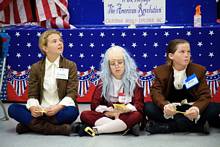-
AMERICAN REVOLUTION - STANDARDS

Walk Through the American Revolution is specifically designed to involve students in the California Arts Standards for Theatre, English Language Arts and History-Social Science – colonial, pre-Revolution, and Revolutionary war events.
Presenters lead students in activities that help them become actively involved in learning about history, as well as foster cooperation, recall, and critical thinking. Activities include a puzzle map, dramatic reenactments of historical events, and a summary and review of important events and people.
State of California English Language Arts Standards for Public Schools
State of California Arts Standards for Theater in Public Schools
State of California History-Social Science Content Standards for Public Schools
5.3 Students describe the cooperation and conflict that existed among the American Indians and between the Indian nations and the new settlers.
5.3.3 Examine the conflicts before the Revolutionary War (e.g., the Pequot and King Philip’s Wars in New England, the Powhatan Wars in Virginia, the French and Indian War).
5.4 Students understand the political, religious, social, and economic institutions that evolved in the colonial era.5.4.1 Understand the influence of location and physical setting on the founding of the original 13 colonies, and identify on a map the locations of the colonies and of the American Indian nations already inhabiting these areas.
5.4.2 Identify the major individuals and groups responsible for the founding of the various colonies and the reasons for their founding (e.g., John Smith, Virginia; Roger Williams, Rhode Island; William Penn, Pennsylvania; Lord Baltimore, Maryland; William Bradford, Plymouth; John Winthrop, Massachusetts).
5.4.7Explain the early democratic ideas and practices that emerged during the colonial period, including the significance of representative assemblies and town meetings.
5.5 Students explain the causes of the American Revolution.
5.5.1 Understand how political, religious, and economic ideas and interests brought about the Revolution (e.g., resistance to imperial policy, the Stamp Act, the Townshend Acts, taxes on tea, Coercive Acts).
5.5.2 Know the significance of the first and second Continental Congresses and of the Committees of Correspondence.
5.5.3 Understand the people and events associated with the drafting and signing of the Declaration of Independence and the document’s significance, including the key political concepts it embodies, the origins of those concepts, and its role in severing ties with Great Britain.
5.5.4 Describe the views, lives, and impact of key individuals during this period (e.g., King George III, Patrick Henry, Thomas Jefferson, George Washington, Benjamin Franklin, John Adams).
5.6 Students understand the course and consequences of the American Revolution.
5.6.1 Identify and map the major military battles, campaigns, and turning points of the Revolutionary War, the roles of the American and British leaders, and the Indian leaders’ alliances on both sides.
5.6.2 Describe the contributions of France and other nations and of individuals to the out-come of the Revolution (e.g., Benjamin Franklin’s negotiations with the French, the French navy, the Treaty of Paris, The Netherlands, Russia, the Marquis Marie Joseph de Lafayette, Tadeusz Ko´sciuszko, Baron Friedrich Wilhelm von Steuben).
5.6.3 Identify the different roles women played during the Revolution (e.g., Abigail Adams, Martha Washington, Molly Pitcher, Phyllis Wheatley, Mercy Otis Warren).
- Presentations
-
Teachers
CALIFORNIAAMERICAN REVOLUTIONANCIENT WORLDOTHER RESOURCES
- Students/Parents
- Reservations
- Photos
-
About
ABOUT CALIFORNIA WEEKLYIN THE PRESS
- Contact Us
- Presentations
- -- What is a Walk Through?
- -- Walk Through California
- -- Walk Through American Revolution
- -- Walk Through Ancient World
- Teachers
- -- CALIFORNIA
- ---- Overview
- ---- Class Activities
- ---- Preparation Tips
- ---- Costumes
- ---- State Standards
- ---- Photos
- ---- Walk Through California Teacher Preparation Guides
- -- AMERICAN REVOLUTION
- ---- Overview
- ---- Class Activities
- ---- Preparation Tips
- ---- Costumes
- ---- State Standards
- ---- Photos
- ---- Walk Through the American Revolution Teacher Preparation Guides
- -- ANCIENT WORLD
- ---- Overview
- ---- Class Activities
- ---- Preparation Tips
- ---- Costumes
- ---- State Standards
- ---- Photos
- ---- Walk Through the Ancient World Teacher Preparation Guides
- -- OTHER RESOURCES
- ---- Teachers FAQs
- ---- Useful Forms/Templates
- ---- Photo Gallery
- Students/Parents
- -- CALIFORNIA
- ---- Overview
- ---- Historical Attire
- ---- California Expert Card
- ---- More Information About California
- ---- California Rancho Information
- ---- Photos
- -- AMERICAN REVOLUTION
- ---- Overview
- ---- Historical Attire
- ---- American Revolution Student Cards
- ---- More Information About American History
- ---- Photos
- -- ANCIENT WORLD
- ---- Overview
- ---- Historical Attire
- ---- Ancient World Student Cards
- ---- More Information About Ancient World
- ---- Photos
- -- OTHER RESOURCES
- ---- Memorization And Acting Tips
- ---- Parent FAQs
- ---- Parent Helper Information
- Reservations
- -- Make a Reservation/Fill in Reservation Itinerary Details
- -- FAQs
- -- Pricing Information
- Photos
- -- California
- -- American Revolution
- -- Ancient World
- About
- -- ABOUT CALIFORNIA WEEKLY
- ---- History of California Weekly
- ---- Employment Opportunities
- ---- Our Presenters
- -- IN THE PRESS
- ---- Fan Mail
- ---- Reviews
- ---- In The News
- Contact Us

